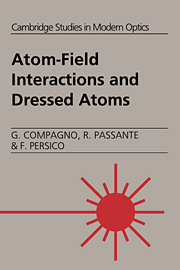Book contents
- Frontmatter
- Contents
- Preface
- 1 The classical electromagnetic field in the absence of sources
- 2 The quantum electromagnetic field in the absence of sources
- 3 The quantum matter field
- 4 Electrodynamics in the presence of sources
- 5 Atoms dressed by a real e.m. field
- 6 Dressing by zero-point fluctuations
- 7 Energy density around dressed atoms
- 8 Further considerations on the nature of dressed states
- Appendix A Multipolar expansion for the vector potential
- Appendix B Electric polarization and magnetization of the Schrödinger field
- Appendix C Rayleigh-Schrödinger perturbation theory
- Appendix D Sum rules for the nonrelativistic hydrogen atom
- Appendix E From Gauss system to SI
- Appendix F Gauge invariance and field interactions
- Appendix G Dressed sources in relativistic QED and in QCD
- Appendix H The energy-momentum tensor and Lagrangian density
- Appendix I The dressed relativistic hydrogen atom
- Appendix J The nonrelativistic Lamb shift in a hydrogenic atom
- Index
Appendix F - Gauge invariance and field interactions
Published online by Cambridge University Press: 12 November 2009
- Frontmatter
- Contents
- Preface
- 1 The classical electromagnetic field in the absence of sources
- 2 The quantum electromagnetic field in the absence of sources
- 3 The quantum matter field
- 4 Electrodynamics in the presence of sources
- 5 Atoms dressed by a real e.m. field
- 6 Dressing by zero-point fluctuations
- 7 Energy density around dressed atoms
- 8 Further considerations on the nature of dressed states
- Appendix A Multipolar expansion for the vector potential
- Appendix B Electric polarization and magnetization of the Schrödinger field
- Appendix C Rayleigh-Schrödinger perturbation theory
- Appendix D Sum rules for the nonrelativistic hydrogen atom
- Appendix E From Gauss system to SI
- Appendix F Gauge invariance and field interactions
- Appendix G Dressed sources in relativistic QED and in QCD
- Appendix H The energy-momentum tensor and Lagrangian density
- Appendix I The dressed relativistic hydrogen atom
- Appendix J The nonrelativistic Lamb shift in a hydrogenic atom
- Index
Summary
In Section 1.4 we have introduced the concept of gauge transformation for quantum electrodynamics and we have shown that Maxwell's equations are invariant under a combined transformation of the scalar and vector potentials. In Section 3.5 we have seen that the principle of gauge invariance can lead to a Lagrangian for the interacting Schrödinger and electromagnetic field. This possibility, as we will discuss in detail in this appendix, is not limited to nonrelativistic QED, but it applies also to relativistic QED as well as to other fields such as those of electroweak interactions and of quantum chromodynamics. The importance of gauge invariance stems from the fact that field theories that can be obtained by a gauge principle are “renormalizable”, in the sense that all ultraviolet divergences can be removed at all orders of perturbation theory by introducing a finite number of renormalization constants. An extensive discussion of this point would lead us beyond the scope of this book; consequently, in this appendix we will only show how the Lagrangian of relativistic QED can be derived by a gauge principle, and we will extend this to the case of quantum chromodynamics (QCD), where it leads to new and unexpected features.
The Lagrangian of the free Dirac field is given in (3.59).
Information
- Type
- Chapter
- Information
- Atom-Field Interactions and Dressed Atoms , pp. 339 - 344Publisher: Cambridge University PressPrint publication year: 1995
